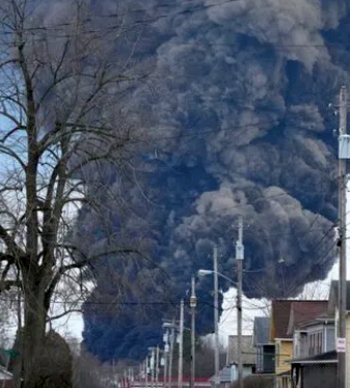Ohio Train Disaster: Investigation Into Lingering Toxic Chemical Contamination

Table of Contents
The Initial Disaster and Immediate Response
The derailment, involving 50 train cars near East Palestine, Ohio, resulted in a fiery inferno and the release of a cocktail of toxic chemicals. The initial emergency response was swift, including mandatory evacuations for thousands of residents within a one-mile radius of the crash site. A controlled burn of the vinyl chloride was implemented to prevent a potentially catastrophic explosion, but this action itself released potentially harmful chemicals into the air, raising significant concerns about immediate and long-term health impacts.
- Chemicals Released: Vinyl chloride (a known carcinogen), butyl acrylate (irritant and potential respiratory hazard), ethylene glycol monobutyl ether (potential reproductive toxin), and others.
- Evacuations and Affected Population: Thousands of residents were evacuated, and many reported experiencing respiratory issues, headaches, and other symptoms. The exact number of those directly affected remains under investigation.
- Initial Assessments: Initial assessments revealed significant contamination of the immediate vicinity, with concerns about air, water, and soil pollution.
Ongoing Environmental Contamination Investigation
The Environmental Protection Agency (EPA), alongside Ohio's environmental agencies, is conducting a comprehensive investigation into the extent of the environmental contamination resulting from the Ohio train derailment. This multifaceted investigation utilizes advanced methodologies to monitor and assess the contamination levels in soil, water, and air across a wide area surrounding the derailment site.
- Locations Under Investigation: The investigation encompasses the immediate vicinity of the derailment, including nearby waterways, residential areas, and agricultural lands. The scope of testing is expanding based on ongoing data analysis.
- Testing Methods: A variety of testing methods are employed, including soil sampling, water analysis (for both surface water and groundwater), and continuous air quality monitoring. Advanced analytical techniques are being used to identify and quantify the presence of various chemicals.
- Preliminary Findings: Preliminary findings indicate contamination levels exceeding acceptable safety limits in various locations. The long-term impacts of this contamination remain uncertain and are the subject of ongoing investigation and analysis.
Water Contamination Concerns
The potential for long-term water contamination is a major concern. The Ohio River, a crucial source of drinking water for many communities downstream, is under intense scrutiny. The potential for contamination of both surface water and groundwater sources poses significant risks to human health and aquatic ecosystems.
- Water Bodies Affected: The Ohio River, Leslie Run, and other smaller streams and waterways are being closely monitored.
- Testing Results: Water samples are being analyzed for a wide range of contaminants. Results are being continuously evaluated to determine the extent and duration of contamination.
- Long-Term Effects on Aquatic Life: The impact on aquatic life, including fish and other organisms, is a significant concern and is being investigated through ongoing monitoring and biological assessments.
Soil and Air Contamination Analysis
The long-term health and environmental risks associated with soil and air contamination are being assessed. The cleanup process is extensive and may require several years to ensure the affected areas are safe.
- Extent of Soil Contamination: The EPA is conducting extensive soil sampling to determine the extent of contamination and identify areas requiring remediation.
- Long-Term Health Risks: Exposure to contaminated soil and air poses potential long-term health risks, including respiratory problems, cancer, and reproductive issues.
- Effectiveness of Remediation Strategies: The effectiveness of the chosen remediation techniques will be closely monitored over the coming years to ensure their long-term success.
Long-Term Health Effects and Public Health Concerns
The potential long-term health effects on residents, first responders, and wildlife are of paramount concern. Ongoing health monitoring programs are crucial to identify and address any health issues arising from exposure to the released chemicals.
- Specific Health Problems: Potential health problems include respiratory illnesses, neurological disorders, and various cancers associated with exposure to the specific chemicals released during the derailment.
- Resources for Residents: Residents are encouraged to seek medical assistance and utilize available resources to monitor their health and address any concerns.
- Long-Term Health Studies: Long-term epidemiological studies are needed to fully understand the long-term health impacts of the disaster on the affected population.
Legal and Regulatory Ramifications
The Ohio train disaster has triggered numerous legal battles and calls for regulatory reform. Lawsuits have been filed against the railroad company, and investigations into regulatory failures are underway.
- Key Legal Actions: Several lawsuits have been filed against Norfolk Southern, the railroad company responsible for the train.
- Potential Fines and Penalties: Significant fines and penalties are anticipated, with the potential for substantial financial repercussions for the responsible parties.
- Proposed Safety Regulations: This disaster is prompting significant calls for stricter regulations regarding the transportation of hazardous materials.
Conclusion
The Ohio Train Disaster and its lingering toxic chemical contamination pose a significant and ongoing challenge. The investigation into the long-term environmental and health consequences is crucial to ensure public safety and environmental protection. Continued monitoring, comprehensive remediation efforts, and improved regulations are vital to mitigate the long-term impact of this disaster. Stay informed about the ongoing investigation by following updates on the EPA website and other reliable news sources, and advocate for stronger regulations to prevent future disasters involving hazardous materials transportation. Stay informed about the latest developments on the Ohio train derailment updates and the Ohio chemical spill investigation to ensure the safety of your community and advocate for stronger regulations concerning toxic contamination in Ohio.

Featured Posts
-
 210 Enorkoi Miktoy Orkotoy Efeteioy Dodekanisoy Kritiki Eksetasi Toy Boyleymatos
May 19, 2025
210 Enorkoi Miktoy Orkotoy Efeteioy Dodekanisoy Kritiki Eksetasi Toy Boyleymatos
May 19, 2025 -
 The Trial A Complete Breakdown Of Teas Crime And Family Outcome
May 19, 2025
The Trial A Complete Breakdown Of Teas Crime And Family Outcome
May 19, 2025 -
 Fallece Juan Aguilera Primer Espanol En Ganar Un Masters 1000
May 19, 2025
Fallece Juan Aguilera Primer Espanol En Ganar Un Masters 1000
May 19, 2025 -
 I Eorti Toy Eyaggelismoy Tis T Heotokoy Sta Ierosolyma Istoria Kai Paradosi
May 19, 2025
I Eorti Toy Eyaggelismoy Tis T Heotokoy Sta Ierosolyma Istoria Kai Paradosi
May 19, 2025 -
 Gazze Ye Insani Yardim Seferberligi Tirlarla Gelen Destek
May 19, 2025
Gazze Ye Insani Yardim Seferberligi Tirlarla Gelen Destek
May 19, 2025
